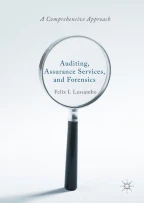Audit Risks: Identification and Procedures

Risks of material misstatement at the financial statement level relate pervasively to the financial statements as a whole and potentially affect many assertions. Inherent risk and control risk are related to the company, its environment, and its internal control, and the auditor assesses those risks based on evidence he or she obtains.
This is a preview of subscription content, log in via an institution to check access.
Access this chapter
Subscribe and save
Springer+ Basic
€32.70 /Month
- Get 10 units per month
- Download Article/Chapter or eBook
- 1 Unit = 1 Article or 1 Chapter
- Cancel anytime
Buy Now
Price includes VAT (France)
eBook EUR 106.99 Price includes VAT (France)
Softcover Book EUR 137.14 Price includes VAT (France)
Hardcover Book EUR 137.14 Price includes VAT (France)
Tax calculation will be finalised at checkout
Purchases are for personal use only
Notes
AU Section 230.12.
Interim Financial Information.
Author information
Authors and Affiliations
- School of Business, Central Connecticut State University, New Britain, CT, USA Felix I. Lessambo
- Felix I. Lessambo
You can also search for this author in PubMed Google Scholar
Corresponding author
Practice
Practice
Which of the following assertion is accurate concerning audit risk?
- (a) Audit risk refers to the risk that the auditor expresses an inappropriate audit opinion
- (b) Audit risk is a function of the risk of material misstatement and detection risk
- (c) Audit risk includes risk of material misstatement
- (d) Audit risk include detection risk
- (e) All of the above
Which of the following assertion is inaccurate concerning the risks of material misstatement?
- (a) Risks of material misstatement can arise from a variety of sources, including external factors
- (b) Risks of material misstatement never occur from the nature or the activities of a company
- (c) Risks of material misstatement may relate to personnel who lack the necessary financial reporting competencies
- (d) Risks of material misstatement may result from information systems that fail to accurately capture business transactions.
Which of the following Assertion is inaccurate concerning the auditor’s inquiry regarding fraud?
- (a) Inquiries of management concerning its knowledge of fraud, alleged fraud, or suspected fraud affecting the company
- (b) Inquiries of the audit committee, or its equivalent as to the fraud risks facing the company
- (c) Inquiries of appropriate internal audit personnel regarding its knowledge of fraud
- (d) Inquiries of the management structure
Which one of the following is not included in fraud risk factors?
- (a) An incentive or pressure to perpetrate fraud
- (b) An opportunity to carry out the fraud
- (c) An attitude or rationalization that justifies the fraudulent action.
- (d) A commingling of the function of the CEO and Chairman of the board of directors
Which one of the below assertions is incorrect concerning fraud risk factors?
- (a) Fraud risk factors do not necessarily indicate the existence of fraud
- (b) Fraud risk factors often are present in circumstances in which fraud exists
- (c) Fraud risk factors may be unintentional
- (d) The auditor’s identification of fraud risks should include the risk of management override of controls

